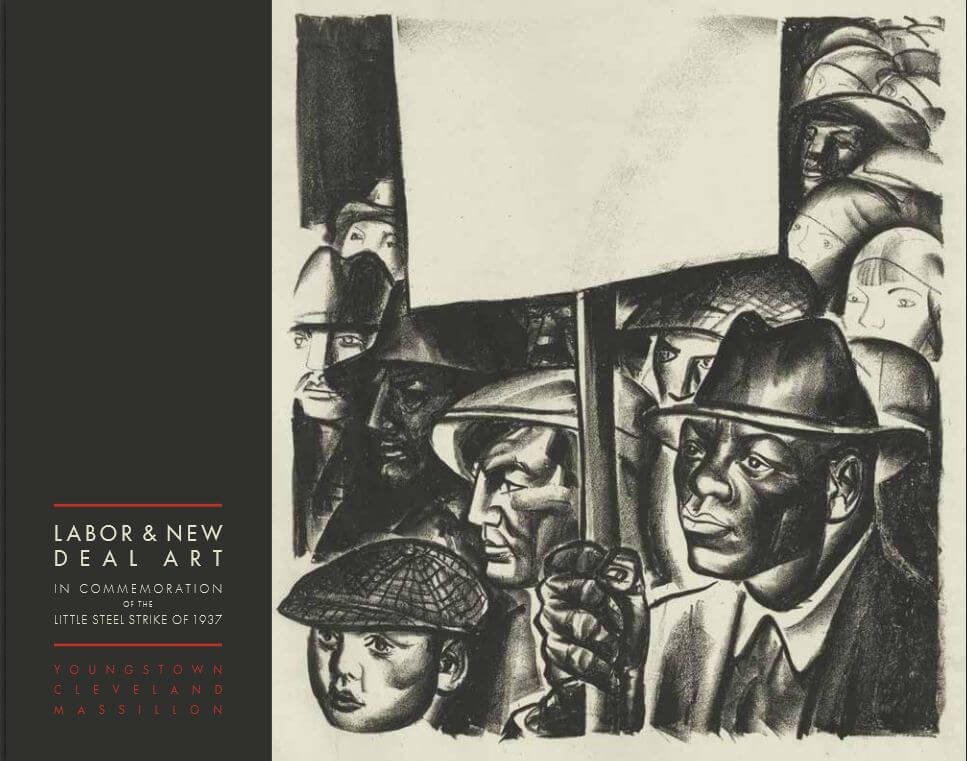Labor and New Deal Art: the Commemoration of the Little Steel Strike of 1937 is a wonderful resource for labor historians and teachers, especially those who like to use visuals to generate discussions in their classrooms. I’m teaching a course on the mid- twentieth century this semester, and plan to use this along with some other resources discussed below in the class. I encourage you to order a copy to support the project and as an addition to your collection.
The story of how the booklet was produced mirrors the connections between art and politics in the New Deal era. It was a collaboration between workers, unions and academics, including LAWCHA member Andrew Bonthius. Tom Sodders, a retired Ohio truck driver, had started collecting New Deal era prints from around the Ohio area. When he learned that Youngstown State University and the Massillon Museum were going to host a commemoration of the Little Steel Strike, he offered his collection, which provided half the material. He also ended up writing a fabulous introduction in the booklet on the Little Steel Strike as well as “Politics and New Deal Art.” Academics and museum staff give background to each of the art works in the booklet. A traveling exhibit of the art was funded by the Ohio Humanities Council. In Cleveland the exhibit resulted in a Labor Fest, funded by area unions, which was filmed and is available in a youtube series. The series includes short vignettes on history, a talk by Boston University art historian Patricia Hill, a discussion about Joe Jones by Melissa Wolfe, Curator of American Art at Columbus Museum of Art (my favorite, though note that only one of Jones pieces is in the booklet) as well as theatrical and musical performances.

I use art and photographs as a regular part of my classes. I ask students to interpret the art, and this usually produces valuable discussions and analysis that allows them to contextualize their readings. This booklet has enough to hone in on and to interpret, especially if used in conjunction with The Great Depression series excerpt “Mean Things Happening”, which uses oral history and period footage to depict the context of Little Steel Strike as a political and social movement that was both about winning rights and defiantly confronting the use of strikebreakers, thugs and stool pidgeons that were key business strategies. The film shows that the fight for civil liberties was at the heart of the quest for union rights, and that is also reflected in the art in the booklet here. In addition, the film shows how the New Deal allowed Northern workers to win some degree of rights while frankly depicting the unholy alliance that gave few rights to Southern workers. It includes live footage not only of the Memorial Day Massacre in Chicago, where 10 workers lost their lives and 9 were permanently maimed from an armed attack on their parade by private mercenaries and Chicago cops. Finally, you wouldn’t want to miss the film’s depiction of the sneering testimony of Republic Steel’s Tom Girdler before the Senate Civil Liberties Committee.
Even without the film or reading complement, showing students images from Labor and New Deal Art would provoke great class discussions and perspectives about the past. In addition, the scenes of hardship during the Great Depression will open up a variety of possible discussion points. The artists in the collection, using various paper media from woodcut to oil, show obvious sympathy for the unemployed and workers’ rights. The text explains that many of depictions were funded by the Federal Writers Project; in many areas of the country such art was destroyed when controversy surrounded them; it might be valuable to ask students what in the scenes depicted was controversial. Sympathy for the unemployed, the power in the ordinary men and women (in truth, there are few women depicted in these scenes, but those that are show them as powerful figures, too, even when pregnant. In others, thugs, corrupt politicians and agents provocateur are depicted as the unvarnished factor in strikes and daily life. Workers bodies are trampled yet undaunted, both in the art surrounding strikes and on the long unemployment lines. Most of the artists were from elite backgrounds and sympathetic to the Communist Party, and their belief in workers collective potential manage to turn depressing scenes of brutality into hopeful scenes, in which the bodies of the mass of workers were the latent power of the period.
I’d love to hear from anyone who attended any of these art showings, and also hear more about the events surrounding this traveling exhibit.
You can contact Andrew Bonthius for a copy of the booklet. Purchasing the booklet will help defray the continuing costs for the project. Besides, you’ll have a great piece for your labor history collection.






